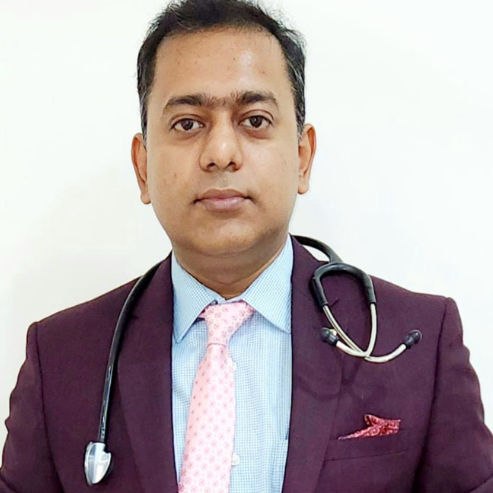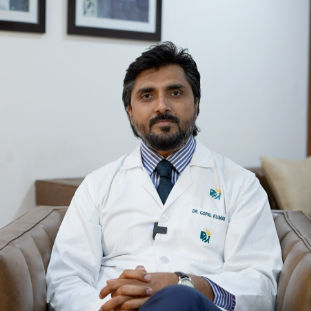Understanding Glioma: Causes, Symptoms, and Risk Factors
The mystery of glioma brain tumours. Learn what causes them, how they lead to symptoms like headaches and seizures, and the key risk factors you should know. Your guide to understanding this complex condition.

Written by Dr. Shaik Abdul Kalam
Reviewed by Dr. D Bhanu Prakash MBBS, AFIH, Advanced certificate in critical care medicine, Fellowship in critical care medicine
Last updated on 19th Sep, 2025

Introduction
A diagnosis of a brain tumour, particularly a glioma, can be overwhelming and raise countless questions. What is happening inside the brain? What causes these tumours to develop, and how do they create the symptoms you or a loved one might be experiencing? Glioma is not a single disease but a category of primary brain tumours that originate from glial cells, the supportive tissue of the brain. This article will demystify the journey from a cellular change to the manifestation of symptoms. We will explore the underlying causes and risk factors, break down how a tumour's location and growth directly lead to specific neurological signs, and provide a clear understanding of this complex condition.
What Exactly is a Glioma?
A glioma is a type of tumour that originates in the brain or spinal cord. The name comes from "glia," or glial cells, which are the supportive cells that surround and insulate neurons (nerve cells), providing them with nutrients and oxygen. Unlike neurons, which do not typically divide and replicate in adulthood, glial cells can sometimes acquire mutations that cause them to grow uncontrollably, forming a mass known as a glioma.
Consult an Oncologist for Personalised Advice
The Role of Glial Cells in the Brain
Think of glial cells as the essential infrastructure and maintenance crew for the brain's neural network. There are several types:
Astrocytes: Support and repair the blood-brain barrier and regulate nutrients.
Oligodendrocytes: Create the myelin sheath that insulates nerve fibres, allowing for fast electrical signalling.
Ependymal cells: Line the fluid-filled ventricles of the brain.
A tumour can arise from any of these cell types, leading to diagnoses like astrocytomas, oligodendrogliomas, or ependymomas.
Grades of Glioma: From Benign to Malignant
Gliomas are classified by the World Health Organisation (WHO) on a scale from I to IV based on how aggressive they appear under a microscope (their histology).
Grade I & II (Low-Grade): These tumours are slower-growing and less aggressive. They may be considered benign, but even low-grade gliomas can be serious due to their location in the brain.
Grade III & IV (High-Grade): These are malignant, fast-growing cancers that invade nearby brain tissue. Glioblastoma (GBM), a Grade IV tumour, is the most aggressive and common form of malignant brain tumour in adults.
The Root Causes: What Triggers Glioma Development?
The exact, singular cause of most gliomas remains unknown. However, scientific consensus points to a combination of accumulated genetic mutations and certain risk factors.
The Role of Genetic Mutations
At its core, glioma development is a story of DNA gone awry. Random, acquired mutations (somatic mutations) in the genes of glial cells disrupt the normal cycle of cell growth, division, and death. Key genes often involved are:
Tumour suppressor genes (e.g., p53, PTEN): These are the "brakes" on cell division. When mutated, the brakes fail.
Oncogenes (e.g., EGFR): These are the "accelerators" of cell division. When mutated, they get stuck in the "on" position.
It's typically not one mutation but a series of them over time that ultimately allows a cell to become cancerous.
Known Genetic Syndromes Linked to Glioma
In a small percentage of cases, people inherit a genetic predisposition. Conditions like Neurofibromatosis type 1, Li-Fraumeni syndrome, and Turcot syndrome are associated with a higher lifetime risk of developing gliomas and other tumours. However, these hereditary cases account for a minority of diagnoses.
Key Risk Factors for Glioma
While most people with these risk factors never develop a brain tumour, research has identified several associations.
Ionising Radiation Exposure
This is the strongest and most well-established environmental risk factor. Previous radiation therapy to the head, often used to treat other cancers like childhood leukaemia, significantly increases the risk of developing a glioma later in life. Routine diagnostic X-rays and CT scans use much lower doses, and the associated risk, if any, is very small.
Age, Gender, and Family History
Age: The risk of most brain tumours, including glioblastoma, increases with age, peaking in adults between 60 and 80 years old. However, certain types, like pilocytic astrocytomas, are more common in children and young adults.
Gender: Men are generally at a slightly higher risk than women for developing a glioma.
Family History: Having a first-degree relative (parent, sibling, child) with a glioma slightly increases your risk, though the overall genetic link is not strong for most people.
The Ongoing Debate: Cell Phones and Environmental Factors
The potential link between cell phone use and brain tumours has been extensively studied. To date, major studies from organisations like the World Health Organisation's International Agency for Research on Cancer (IARC) have classified radiofrequency fields as "possibly carcinogenic," but no conclusive evidence has established a direct causal link. Research is ongoing.
How a Glioma Leads to Neurological Symptoms
A glioma doesn't have to be large to cause significant problems. Symptoms arise through several key mechanisms related to the tumour's presence in the confined space of the skull.
The Mass Effect: Pressure and Compression
As the tumour grows, it takes up space, increasing pressure inside the rigid skull (intracranial pressure). This pressure can compress sensitive brain structures, blood vessels, and the cerebrospinal fluid pathways, leading to a classic symptom: persistent, worsening morning headaches.
Infiltration and Invasion of Brain Tissue
Unlike many tumours that form a discrete lump, gliomas, especially high-grade ones, have tentacle-like projections that infiltrate and spread through the healthy brain tissue. This invasion directly destroys and disrupts the function of neurons in that area.
Disruption of Normal Brain Circuitry
The brain works through complex electrical and chemical pathways. A tumour can act as a physical roadblock or a source of "electrical noise," interrupting these critical circuits. This is a primary reason for symptoms like seizures, which are essentially sudden, uncontrolled electrical disturbances in the brain.
Common Symptoms of a Glioma
The symptoms of a brain tumour are notoriously variable and depend heavily on the tumour's location, size, and growth rate.
Headaches: More Than Just a Migraine
While headaches are common, glioma headaches often have distinct characteristics: they are often worse in the morning or wake you from sleep, may be accompanied by nausea or vomiting, and can worsen with coughing, straining, or changing position.
Seizures: An Electrical Storm in the Brain
Seizures are frequently the first sign of a glioma, especially a low-grade one. They can be dramatic convulsions or more subtle, like a brief lapse in awareness, a strange smell or taste, or uncontrolled jerking of a limb.
Cognitive and Personality Changes
These can be subtle and mistakenly attributed to stress or ageing. They may include memory problems, confusion, difficulty concentrating, apathy, and uncharacteristic changes in behaviour or personality.
Focal Neurological Deficits (Location-Specific Symptoms)
Where the tumour is located dictates specific functional losses:
Frontal Lobe: Weakness on one side of the body, speech difficulty (if on the left), loss of initiative.
Temporal Lobe: Memory problems, difficulty understanding language, seizures.
Parietal Lobe: Sensory changes, neglect of one side of the body, difficulty with spatial tasks.
Occipital Lobe: Vision loss or disturbances.
Cerebellum: Loss of coordination, balance problems, dizziness.
When to Seek Medical Advice
It is crucial to understand that the symptoms listed above are most often caused by conditions far less serious than a brain tumour, such as migraines, stress, or infections. However, you should consult a doctor if you experience:
A new, persistent headache that is different from your usual pattern.
A first-time seizure.
Sudden or progressive weakness, numbness, or vision changes.
Significant and unexplained changes in memory or personality.
If symptoms are persistent, progressive, or severe, it is essential to get a professional evaluation. If your symptoms persist beyond two weeks or suddenly worsen, consult a doctor online with Apollo24|7 for further evaluation and to discuss the need for imaging.
Conclusion
Understanding what leads to glioma and its symptoms is the first step in demystifying this daunting diagnosis. While the exact trigger for the initial genetic mutation often remains unknown, we have a clear picture of how these tumors behave and affect brain function. Recognising the potential signs—from the distinct pattern of a glioma headache to the sudden onset of a seizure—empowers you to seek timely medical attention. Remember, most symptoms have benign causes, but professional evaluation is key to ruling out serious conditions. Advancements in treatment, including surgery, radiation, and chemotherapy, are continually improving outcomes.
Consult an Oncologist for Personalised Advice
Consult an Oncologist for Personalised Advice

Dr Sunita Samleti
Oncologist
18 Years • M.D. (Pathology)- TN Medical College, Mumbai University, Mumbai, Mar 2005 M.B.B.S. Grant Medical College, Mumbai University, Mumbai, Oct 1999
Chinagadila
Apollo Hospitals Health City Unit, Chinagadila

Dr. Sanchayan Mandal
Medical Oncologist
17 Years • MBBS, DNB Raditherapy, DrNB Medical Oncology
East Midnapore
VIVEKANANDA SEBA SADAN, East Midnapore

Dr Gowshikk Rajkumar
Oncologist
10 Years • MBBS, DMRT, DNB in Radiation oncology
Bengaluru
Apollo Clinic, JP nagar, Bengaluru

Dr.sanchayan Mandal
Medical Oncologist
17 Years • MBBS, DrNB( MEDICAL ONCOLOGY), DNB (RADIOTHERAPY),ECMO. PDCR. ASCO
Kolkata
Dr. Sanchayan Mandal Oncology Clinic, Kolkata

Dr. Gopal Kumar
Head, Neck and Thyroid Cancer Surgeon
15 Years • MBBS, MS , FARHNS ( Seoul, South Korea ), FGOLF ( MSKCC, New York )
Delhi
Apollo Hospitals Indraprastha, Delhi
(25+ Patients)
Frequently Asked Questions
1. Can lifestyle choices like diet or stress cause a glioma?
There is no conclusive scientific evidence linking specific diets, stress, or lifestyle choices to the development of gliomas. The primary identified risk factors are genetic predisposition and exposure to ionising radiation.
2. What is the difference between a primary brain tumour like a glioma, and a secondary one?
A primary brain tumour, such as a glioma, originates from cells within the brain or its coverings. A secondary (or metastatic) brain tumour has spread to the brain from a cancer that started elsewhere in the body (e.g., lung, breast).
3. Are all gliomas cancerous?
While often used interchangeably with 'cancer,' the term 'malignant' is more precise. Low-grade (Grade I & II) gliomas may be benign or borderline, meaning they grow slowly. High-grade (Grade III & IV) gliomas are malignant, meaning they are cancerous, aggressive, and invasive.
4. If I have a headache, should I immediately worry about a brain tumour?
No. Headaches are extremely common and are usually caused by tension, migraines, dehydration, or sinus issues. Red flags for a glioma headache include a new pattern, worsening intensity, occurrence in the morning, and association with nausea/vomiting or neurological symptoms.
5. How is a glioma diagnosed?
The cornerstone of diagnosis is neuroimaging, primarily an MRI (Magnetic Resonance Imaging) scan with contrast dye. This provides detailed images of the brain. A definitive diagnosis, including the tumour grade and type, requires a biopsy, where a sample of the tumour is removed and analysed by a pathologist.